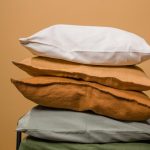Are you tired of the worn-out look of your leather bed frame? Transform it into a stylish statement piece by reupholstering it with fabric.
In this article, we will guide you through the step-by-step process of how to reupholster a leather bed frame with fabric. From selecting the right fabric to creating a smooth and professional finish, we have all the tips and tricks you need to achieve a stunning result.
So, let’s get started and give your bed frame a much-needed makeover.
Table of Contents
Selecting the Right Fabric for Your Bed Frame
You’ll want to choose a fabric that is durable and complements the style of your bed frame. When considering fabric durability, opt for materials like linen, cotton, or polyester blends that can withstand regular use and maintain their appearance over time. These fabrics are resistant to wear and tear, ensuring that your reupholstered bed frame will last for years to come.
In addition to fabric durability, color coordination is also important. You’ll want to select a fabric color that complements the overall aesthetic of your bedroom. Consider the existing color scheme and decor style in your room to ensure that the fabric you choose enhances the overall look and feel of the space.
When it comes to selecting the fabric, take the time to explore different options and consider samples before making a final decision. Look for fabrics that are easy to clean and maintain, as this will make it easier to keep your bed frame looking fresh and beautiful.
Overall, choosing the right fabric for your bed frame involves considering both fabric durability and color coordination. By selecting a durable fabric that complements your bed frame’s style and color scheme, you can create a cohesive and long-lasting piece of furniture that enhances the overall aesthetic of your bedroom.
Preparing Your Leather Bed Frame for Reupholstering
Before you begin reupholstering your leather bed frame with fabric, it’s important to prepare the surface properly.
Start by cleaning the leather surface thoroughly to remove any dirt, dust, or stains. You can use a mild soap and water solution or a leather cleaner specifically designed for this purpose.
Once the leather is clean, you’ll need to remove the existing upholstery carefully, taking care not to damage the frame or the leather itself. Use a seam ripper or a small pair of scissors to carefully cut and remove any stitches or staples holding the upholstery in place.
Cleaning the Leather Surface
To start, wipe down the leather surface with a clean cloth to remove any dust or debris. This is an important step in preparing your leather bed frame for reupholstering.
Here are some cleaning techniques to help you get rid of stains and make the surface ready for the new fabric:
-
Use a mild soap and water solution to gently clean the leather. Avoid using harsh chemicals that could damage the material.
-
For stubborn stains, you can try using a leather cleaner specifically designed for removing stains. Follow the instructions on the cleaner and test it on a small, inconspicuous area first.
-
If the stain persists, you may need to use a leather stain remover. Again, test it in a hidden area before applying it to the entire surface.
-
After cleaning, make sure to thoroughly dry the leather before moving on to the reupholstering process.
Removing Existing Upholstery
Once you’ve finished cleaning the surface, it’s time to remove the existing upholstery from your leather bed frame.
Removing upholstery may seem like a daunting task, but with the right techniques, it can be done efficiently.
Start by locating the staples or tacks that secure the upholstery to the frame. Use a staple remover or pliers to carefully remove each staple, taking care not to damage the leather.
Once all the staples are removed, gently pull the upholstery away from the frame, starting from one corner and working your way around.
If the upholstery is glued, use a heat gun to soften the adhesive before peeling it off.
Removing the Existing Upholstery From Your Bed Frame
First, take a pair of pliers and carefully remove the staples holding the existing upholstery on your bed frame. This step is crucial in preparing the frame for the reupholstering process. Once the staples are removed, you can start selecting the right tools and techniques for reupholstering your bed frame with fabric.
Here are three important things to keep in mind when selecting upholstery tools and reupholstering techniques:
-
Staple remover: Invest in a high-quality staple remover that can efficiently remove staples without damaging the frame or the fabric. Look for one with a comfortable grip and sharp tips for easy use.
-
Upholstery fabric: Choose a fabric that suits your style and complements the overall aesthetic of your bedroom. Consider factors such as durability, color, pattern, and texture. Opt for a fabric that is specifically designed for upholstery projects, as it will be more durable and resistant to wear and tear.
-
Upholstery techniques: There are various techniques you can use to reupholster your bed frame. Some common techniques include stapling the fabric directly to the frame, using a fabric adhesive, or sewing a slipcover to go over the existing upholstery. Research and choose the technique that best suits your skills and desired outcome.
Measuring and Cutting the Fabric for Reupholstering
Now that you’ve successfully removed the existing upholstery from your bed frame, it’s time to move on to the next step: measuring and cutting the fabric for reupholstering. This process is crucial to ensure a precise fit and a professional-looking finish.
To begin, gather your measuring tools such as a measuring tape, ruler, and fabric marker. Start by measuring the length and width of each section of the bed frame that needs to be upholstered. Make sure to measure from edge to edge and add a few inches to account for seam allowances.
Next, lay out your fabric on a flat surface and use your measurements to mark the dimensions of each section. A fabric marker or chalk can be used to create accurate lines. Take into consideration any patterns or designs on the fabric and ensure they are aligned correctly.
Now, it’s time to cut the fabric. Use sharp cutting tools such as fabric scissors or a rotary cutter to make clean and precise cuts along the marked lines. Take your time and cut slowly to avoid any mistakes or uneven edges.
Attaching the New Fabric to Your Bed Frame
When it comes to attaching the new fabric to your bed frame, there are a few key points to keep in mind.
First, choosing the right fabric is crucial for a successful reupholstering project. Make sure to select a fabric that is durable, easy to clean, and matches your desired aesthetic.
Second, applying the adhesive properly is essential for a secure and long-lasting bond. Follow the manufacturer’s instructions and use a brush or roller to evenly spread the adhesive on both the frame and the fabric.
Lastly, securing the corners and edges will give your reupholstered bed frame a polished look. Use staples or a staple gun to secure the fabric tightly, making sure to fold and tuck any excess fabric neatly.
Fabric Selection Tips
To choose the best fabric for reupholstering a leather bed frame, consider the durability and color options available. Here are three tips for selecting the perfect fabric:
-
Select appropriate patterns: When choosing a fabric pattern, consider the overall style and theme of your bedroom. Opt for patterns that complement the existing decor and create a cohesive look. Popular choices include stripes, florals, and geometric designs.
-
Consider durability: Since the bed frame is subjected to daily wear and tear, it’s important to choose a fabric that can withstand the test of time. Look for fabrics that are tightly woven and have a high rub count. Fabrics such as cotton, linen, and microfiber are known for their durability and can handle frequent use.
-
Think about maintenance: Consider the maintenance requirements of the fabric. Some fabrics may require special cleaning methods or may be more prone to staining. Choose a fabric that is easy to clean and maintain, ensuring that your bed frame stays looking fresh and new for years to come.
Proper Adhesive Application
Using a high-quality adhesive is essential for properly securing the fabric to the bed frame. When it comes to adhesive types, there are a few options to consider.
One popular choice is a spray adhesive, which provides an even and strong bond. Another option is a fabric glue, which works well for smaller areas and intricate designs. Whichever adhesive you choose, it’s important to apply it properly for optimal results.
Start by cleaning the bed frame surface thoroughly, removing any dust or grease. Apply the adhesive evenly over the surface, making sure to cover the entire area. Press the fabric firmly onto the adhesive, smoothing out any wrinkles or bubbles.
Allow the adhesive to dry completely before moving or using the bed frame. Proper adhesive application is key to ensuring a successful fabric reupholstery project.
Securing Corners and Edges
Securing the corners and edges of your project is crucial for a professional and polished finish. To ensure that your reupholstered leather bed frame looks its best, here are four securing techniques and corner reinforcement tips to follow:
-
Stapling: Use a staple gun to secure the fabric tightly to the frame, starting from the corners and working your way towards the center. This will create a neat and secure finish.
-
Corner reinforcement: To prevent the fabric from fraying or tearing at the corners, reinforce them with corner brackets or metal corner protectors. These will add extra strength and durability.
-
Trim excess fabric: After securing the corners, trim any excess fabric to create clean lines and a tidy appearance. Use sharp fabric scissors to achieve precise cuts.
-
Glue or adhesive: Apply a small amount of fabric glue or adhesive to the edges of the fabric to prevent it from unraveling over time. This will provide extra security and longevity to your reupholstered bed frame.
Creating a Smooth and Professional Finish
For a smooth and professional finish on your reupholstered leather bed frame, make sure to carefully remove any wrinkles or creases in the fabric before securing it in place. A smooth finish not only enhances the overall appearance of your bed frame but also ensures longevity and durability.
To achieve a smooth finish, start by laying out the fabric on a clean, flat surface. Smooth out any wrinkles or folds using your hands or a fabric steamer. If necessary, you can also use an iron on a low heat setting, making sure to place a cloth between the iron and the fabric to prevent any damage.
Once the fabric is wrinkle-free, center it over the bed frame and start securing it in place. Begin with the corners, pulling the fabric tightly and using upholstery pins or staples to hold it in position. Work your way around the frame, pulling the fabric taut as you go.
To create a professional appearance, ensure that the fabric is evenly stretched across the entire frame. Smooth out any lumps or bumps as you secure the fabric, taking care to maintain a consistent tension throughout.
Tips and Tricks for Maintaining Your Reupholstered Bed Frame
To keep your newly upholstered bed looking its best, remember to regularly clean and condition the material. Maintaining fabric upholstery is essential for preserving its beauty and longevity.
Start by vacuuming your bed regularly to remove any dust or debris that may accumulate on the surface. Use a soft brush attachment to gently brush away any dirt or crumbs that may be stuck in the fabric.
For stains, act quickly and blot the area with a clean cloth to absorb as much of the liquid as possible. Avoid rubbing the stain, as this may spread it further. Use a mild detergent or upholstery cleaner specifically designed for fabric to treat the stain. Before using any cleaning product, test it on a small, inconspicuous area of the fabric to ensure it does not cause any damage or discoloration. Once the stain is treated, blot the area again with a clean cloth to remove any residue.
Lastly, to prevent future fabric stains, consider using a fabric protector spray. This spray creates a barrier on the fabric, making it more resistant to spills and stains. Follow the manufacturer’s instructions for application and reapply as needed.
Conclusion
In conclusion, reupholstering your leather bed frame with fabric is a great way to give it a fresh new look. By selecting the right fabric, properly preparing the bed frame, and following the steps for removing the existing upholstery and attaching the new fabric, you can achieve a smooth and professional finish.
Remember to maintain your reupholstered bed frame by regularly cleaning and caring for the fabric. With a little effort, you can transform your bed frame and enjoy a stylish and comfortable space to rest and relax.
- Understanding Fabric Weight: Why Heavy Duchess Satin Is a Designer Favorite - June 24, 2025
- Polyester vs. Silk Duchess Satin: A Head-to-Head Comparison - June 24, 2025
- The History of Duchess Satin: From Royal Courts to Modern Couture - June 24, 2025





